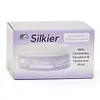What's inside
What's inside
 Key Ingredients
Key Ingredients

No key ingredients
 Benefits
Benefits

 Concerns
Concerns

 Ingredients Side-by-side
Ingredients Side-by-side

Water
Skin ConditioningPropanediol
SolventCetearyl Alcohol
EmollientHydrogenated Polydecene
EmollientDiglycerin
HumectantDimethicone
EmollientButyrospermum Parkii Butter
Skin ConditioningSqualane
EmollientPEG-100 Stearate
Glyceryl Stearate
EmollientAmmonium Polyacrylate
StabilisingPhenoxyethanol
PreservativeC13-16 Isoparaffin
SolventLaureth-30
CleansingXanthan Gum
EmulsifyingGlycerin
HumectantCaprylyl Glycol
EmollientOctyldodecanol
EmollientSodium Hyaluronate
HumectantHydrogenated Lecithin
Emulsifying1,6-Hexanediamine
BufferingPolyglyceryl-10 Dioleate
EmulsifyingCeramide NP
Skin ConditioningPhytosphingosine
Skin ConditioningCholesterol
EmollientPhospholipids
Skin ConditioningCeramide Ns
Skin ConditioningCeramide Ng
Skin ConditioningCeramide As
Skin ConditioningCeramide AP
Skin ConditioningCeramide EOP
Skin ConditioningWater, Propanediol, Cetearyl Alcohol, Hydrogenated Polydecene, Diglycerin, Dimethicone, Butyrospermum Parkii Butter, Squalane, PEG-100 Stearate, Glyceryl Stearate, Ammonium Polyacrylate, Phenoxyethanol, C13-16 Isoparaffin, Laureth-30, Xanthan Gum, Glycerin, Caprylyl Glycol, Octyldodecanol, Sodium Hyaluronate, Hydrogenated Lecithin, 1,6-Hexanediamine, Polyglyceryl-10 Dioleate, Ceramide NP, Phytosphingosine, Cholesterol, Phospholipids, Ceramide Ns, Ceramide Ng, Ceramide As, Ceramide AP, Ceramide EOP
Water
Skin ConditioningGlycerin
HumectantCetyl Palmitate
EmollientParaffinum Liquidum
EmollientPetrolatum
EmollientCetyl Alcohol
EmollientGlyceryl Hydroxystearate
EmollientSteareth-100
Gel FormingOctyldodecyl Myristate
EmollientDimethicone
EmollientStearic Acid
CleansingPalmitic Acid
EmollientParfum
MaskingPotassium Hydroxide
BufferingDMDM Hydantoin
PreservativeTetrasodium EDTA
Acrylates/C10-30 Alkyl Acrylate Crosspolymer
Emulsion StabilisingCarbomer
Emulsion StabilisingIodopropynyl Butylcarbamate
PreservativeCI 14700
Cosmetic ColorantWater, Glycerin, Cetyl Palmitate, Paraffinum Liquidum, Petrolatum, Cetyl Alcohol, Glyceryl Hydroxystearate, Steareth-100, Octyldodecyl Myristate, Dimethicone, Stearic Acid, Palmitic Acid, Parfum, Potassium Hydroxide, DMDM Hydantoin, Tetrasodium EDTA, Acrylates/C10-30 Alkyl Acrylate Crosspolymer, Carbomer, Iodopropynyl Butylcarbamate, CI 14700
 Reviews
Reviews

Ingredients Explained
These ingredients are found in both products.
Ingredients higher up in an ingredient list are typically present in a larger amount.
Dimethicone is a type of synthetic silicone created from natural materials such as quartz.
What it does:
Dimethicone comes in different viscosities:
Depending on the viscosity, dimethicone has different properties.
Ingredients lists don't always show which type is used, so we recommend reaching out to the brand if you have questions about the viscosity.
This ingredient is unlikely to cause irritation because it does not get absorbed into skin. However, people with silicone allergies should be careful about using this ingredient.
Note: Dimethicone may contribute to pilling. This is because it is not oil or water soluble, so pilling may occur when layered with products. When mixed with heavy oils in a formula, the outcome is also quite greasy.
Learn more about DimethiconeGlycerin is already naturally found in your skin. It helps moisturize and protect your skin.
A study from 2016 found glycerin to be more effective as a humectant than AHAs and hyaluronic acid.
As a humectant, it helps the skin stay hydrated by pulling moisture to your skin. The low molecular weight of glycerin allows it to pull moisture into the deeper layers of your skin.
Hydrated skin improves your skin barrier; Your skin barrier helps protect against irritants and bacteria.
Glycerin has also been found to have antimicrobial and antiviral properties. Due to these properties, glycerin is often used in wound and burn treatments.
In cosmetics, glycerin is usually derived from plants such as soybean or palm. However, it can also be sourced from animals, such as tallow or animal fat.
This ingredient is organic, colorless, odorless, and non-toxic.
Glycerin is the name for this ingredient in American English. British English uses Glycerol/Glycerine.
Learn more about GlycerinWater. It's the most common cosmetic ingredient of all. You'll usually see it at the top of ingredient lists, meaning that it makes up the largest part of the product.
So why is it so popular? Water most often acts as a solvent - this means that it helps dissolve other ingredients into the formulation.
You'll also recognize water as that liquid we all need to stay alive. If you see this, drink a glass of water. Stay hydrated!
Learn more about Water